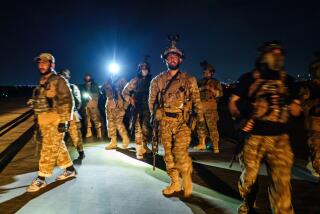War Now Hunt for ‘Man on the Run’
- Share via
WASHINGTON — As tribal fighters battled their way toward a suspected mountain hide-out of Osama bin Laden and the British reportedly prepared to lead peacekeepers into Afghanistan, a senior U.S. defense official asserted Monday that the terrorist chief has become increasingly isolated and vulnerable.
Deputy Defense Secretary Paul D. Wolfowitz said Bin Laden faces a tough choice: keeping the large security force that makes him easier to find, or shedding it and hoping he can hide from opposition forces and bounty hunters without protection.
Painting a bleak portrait of Bin Laden’s situation, Wolfowitz said U.S. officials believe he is losing his capacity to communicate, his influence over his followers and perhaps also his ability to smuggle in the money he needs to function in Afghanistan.
“He doesn’t have a lot of good options,” Wolfowitz said at a Pentagon briefing. “ . . . This is a man on the run.”
Near Tora Bora, where Bin Laden is believed to be hiding, anti-Taliban fighters backed by tanks and U.S. warplanes seized a key ridge near the mountain after a fierce battle with fighters from Bin Laden’s Al Qaeda terrorist network. In southern Afghanistan, U.S. Marines stepped up efforts to capture Taliban and Al Qaeda leaders fleeing Kandahar by setting up a staging area closer to the city.
U.S. forces also made an appearance in the capital, Kabul, as Marines secured the grounds of the U.S. Embassy building that was closed in 1989.
Meanwhile, there were reports that the coalition forces will soon be joined by a British-led multinational peacekeeping force. Diplomats at the United Nations said Monday that an arrangement worked out with the White House could bring the first peacekeepers into Kabul early next week.
U.S. officials have continued to emphasize the difficulties of finding Bin Laden and Mullah Mohammed Omar, the deposed Taliban leader, in the mountainous country. Even so, their statements of recent days suggest that the huge force mobilized to capture them may be making progress, some analysts said.
Bin Laden Entourage Seen as a Liability
Experts noted that Wolfowitz and other defense officials are consistently saying that they believe Bin Laden is in the Tora Bora area that is now encircled by opposition forces and that Omar remains in the area around Kandahar.
“They probably wouldn’t be this forthright unless they had their own evidence that they’re there,” said Michael Vickers, a military analyst at the Center for Strategic and Budgetary Assessments think tank in Washington. “And if they are, both of these guys are in a lot of trouble.”
Bin Laden’s security entourage has become an increasing liability for him as the search has gained momentum, defense officials said.
Although the terrain is rugged and the caves and tunnels are numerous in eastern Afghanistan, U.S. surveillance drones could spot a sizable group of riders in vehicles or on horseback.
Bin Laden is also being pursued on the ground by Special Forces teams and Afghan opposition fighters who know the terrain. And villagers--aware of the $25-million reward for Bin Laden--might also notice the group and turn him in, experts said.
The opposition forces pursuing the Al Qaeda fighters stormed a crucial mountain valley at the base of Tora Bora on Monday, pushing hundreds of Al Qaeda fugitives farther toward the peaks, tribal commanders said.
By nightfall, the predominantly Arab, Chechen and Pakistani fighters were forced deep into their caves near the top of the mountain by invading Afghan troops.
Tribal fighters commandeered a low-lying ring of shallow storage caves and an arsenal of heavy weapons. Four Arabs were killed, and the rest had slim prospects of escaping the mountain, the commanders said.
Commander Hazrat Ali vowed that the group would press on today. “We are going to struggle, we are not going to let them escape,” he said.
The fighting began before sunrise Monday with intense bombing raids by U.S. warplanes. With the help of Special Forces, anti-Taliban soldiers used rocket launchers, Kalashnikov assault rifles and archaic Russian tanks to press to the edge of the Milawa valley. In the afternoon, three squads stole up foot trails and scaled a set of ridges to take the valley, a wide expanse of fields and caves that stretches to the edge of the purported main hide-out.
But the toughest piece of the mission is yet to come: routing the Bin Laden followers from their underground hide-outs. Commanders here say the men have taken to the hills with their wives and children. They say the Al Qaeda members prefer death to surrender.
U.S. forces stepped up their psychological effort against the enemy by dropping one of their huge “daisy cutter” bombs on the entrance to a cave in which Al Qaeda troops and top leaders are suspected of taking refuge.
The 15,000-pound bomb, the largest nonnuclear munition in the U.S. arsenal, ignites a fireball that destroys everything within hundreds of yards. Officials said it was used in part to make the cave entrance impassable, and for the frightening effect that the concussion would presumably have on Al Qaeda fighters.
Rear Adm. John D. Stufflebeem, a senior operations officer for the Joint Chiefs of Staff, noted that the bomb was set off in a narrow valley. Setting off such a huge bomb in such a confined space “should have some kind of negative effect” on those in the caves, he said.
Still, officials in Washington made it clear that the efforts to capture senior Taliban and Al Qaeda leaders have not made much progress so far.
Though U.S. bombs have killed a number of senior enemy leaders, Wolfowitz said he knew of no Al Qaeda or Taliban leaders who were in U.S. custody and no more than three who were in the hands of Afghan opposition groups.
Ground Search Also on for Bin Laden
Finding all the important leaders is “going to be a very long and difficult job,” Wolfowitz said.
To help in the search, U.S. Marines dispatched a dozen helicopters bearing weapons and supplies to a rocky desert site near Kandahar, making it much easier to resupply the roving “hunter-killer” teams with water, food and ammunition. The number of Marines hunting for Al Qaeda leaders was sharply increased, military officials said.
Security of Key Route Uncertain
Kandahar was reportedly calm Monday, one day after a deal was brokered between two opposing warlords by Afghan tribal leader Hamid Karzai, who has been picked in U.N.-sponsored talks to lead an interim administration for the country. But the border town of Spin Buldak continued to be divided between two rival tribes, putting a question mark over security on the main route linking Pakistan and the southern half of Afghanistan.
Officials close to the new Afghan administration voiced optimism that Kandahar would soon return to normal now that the Taliban has left.
“The people of Kandahar are liking this change. They like the peace and security,” Abdul Malik, a cousin of Karzai’s, said after talking by satellite phone to friends in the city.
Malik described Karzai as “absolutely optimistic, as usual,” that Afghanistan would reemerge as a peaceful state.
As a sign of the change in climate in Kandahar, 16 people arrested by the former Taliban regime on various political offenses were freed from the local jail on Karzai’s order. Meanwhile, the newly appointed governor of Kandahar, Gul Agha Shirzai, issued an appeal to former Taliban members to cooperate with the new administration.
Pakistanis Arrest 18 at Border
In Pakistan, Maj. Gen. Rashid Qureshi, a spokesman for President Pervez Musharraf, said Monday that 18 people have been arrested in recent days trying to cross into the country illegally from Afghanistan. Those arrested included Chechens, Arabs and some Pakistanis, he said.
Qureshi said the arrests were made by members of the paramilitary Frontier Corps, which has been deployed along the border in increasing numbers looking for fleeing Taliban fighters and operatives of Al Qaeda.
Richter reported from Washington and Stack from Jalalabad, Afghanistan. Times staff writers John Daniszewski and Kim Murphy in Quetta, Pakistan, and Tony Perry in southern Afghanistan contributed to this report.
More to Read
Sign up for Essential California
The most important California stories and recommendations in your inbox every morning.
You may occasionally receive promotional content from the Los Angeles Times.











